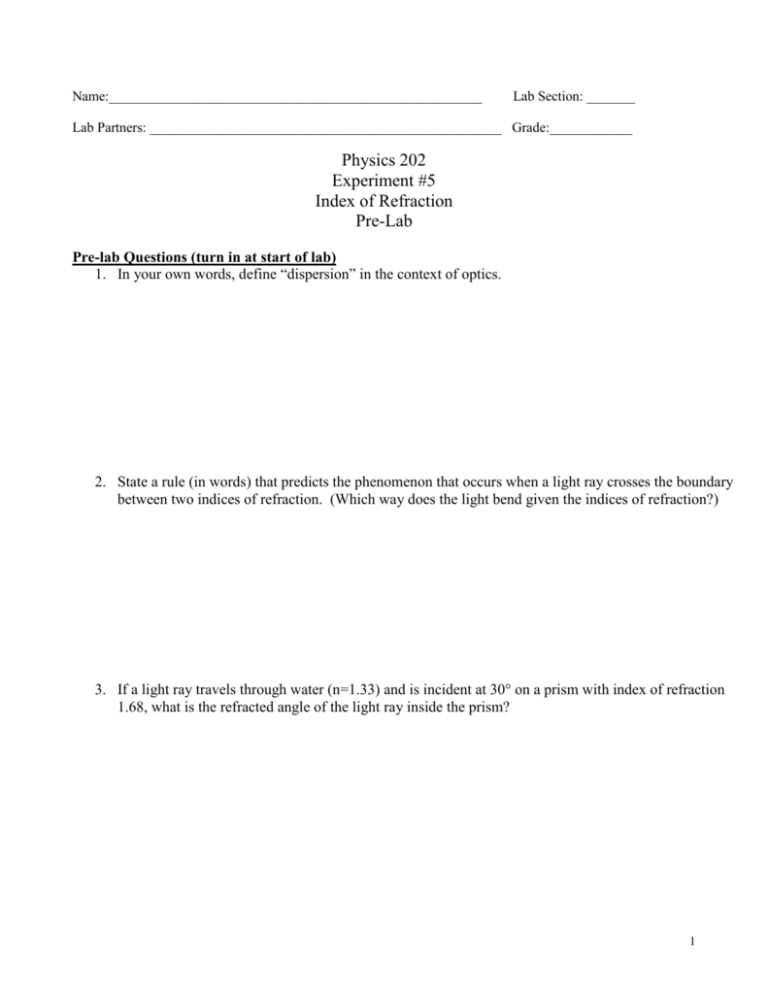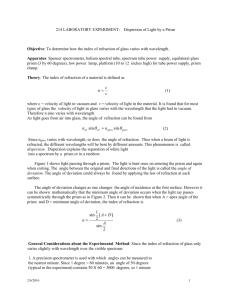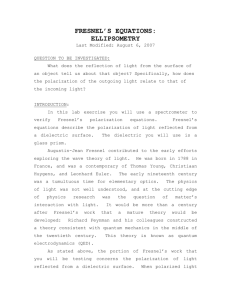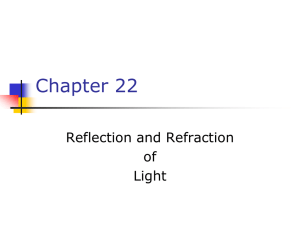Physics Active Learning (PAL)
advertisement

Name:______________________________________________________ Lab Section: _______ Lab Partners: ___________________________________________________ Grade:____________ Physics 202 Experiment #5 Index of Refraction Pre-Lab Pre-lab Questions (turn in at start of lab) 1. In your own words, define “dispersion” in the context of optics. 2. State a rule (in words) that predicts the phenomenon that occurs when a light ray crosses the boundary between two indices of refraction. (Which way does the light bend given the indices of refraction?) 3. If a light ray travels through water (n=1.33) and is incident at 30° on a prism with index of refraction 1.68, what is the refracted angle of the light ray inside the prism? 1 Name:______________________________________________________ Lab Section: ______ Lab Partners: ___________________________________________________ Grade:____________ Physics 202 Experiment #5 Index of Refraction Introduction For this lab you will make an accurate determination of the index of refraction, n, of dense flint glass by measuring the angle through which a given wavelength of light is refracted. The index of refraction of any material is the ratio of the speed of light in a vacuum to the speed of light in the material. n c v (1) Therefore, by measuring the index of refraction, you will be able to calculate the velocity of light through glass. Because your light source, a mercury lamp, is made up of many colors, you will also be able to show the variation of the speed of light as a function of wavelength, known as dispersion. Figure 1. Refraction of light through a prism. Figure 1 shows a ray of light incident on the surface AB of the prism. The angle of incidence is i1, and the angle of refraction is r1. Within the prism, the light travels along the path MN until it is again refracted at the surface AC. The angle of emergence is i2, while the corresponding angle of refraction is r2. Then the total deviation between the original path and the final path is the angle D, where 2 D (i1 r1 ) (i2 r2 ) (2) Moreover, the geometry of Figure 1 also implies that r1 r2 A (3) D i1 i2 A (4) Therefore, Use of Snell's Law, combined with the geometry of Figure 1, allows the calculation of the angles r1, r2 and i2 from the angle i1. Thus, the magnitude of the deviation angle D depends only on the incident angle i1. Also, D will be a minimum for one particular i1. Since the path of the light ray may be reversed in direction, the minimum D occurs when the angles i1 and i2 are equal; otherwise, simply reversing the path of the ray would give another angle (i2) for which D would be a minimum. Let i denote the incidence angle that yields the minimum deviation D, with r being the corresponding refraction angle. From Equation 3, r = A/2. Also, from Equation 4, the minimum angle of deviation, Dm, will be Dm 2i A (5) These two relations may be substituted into Snell's Law, which states that the index of refraction n is given by sin i n (6) sin r The result, which you will use to determine the index of refraction, is D A sin m 2 n A sin 2 (7) Thus, you can determine n by measuring A and Dm. Experimental Setup Familiarize yourself with the spectrometer. A copy of the spectrometer instruction manual can be found in the lab. The spectrometer should already be aligned for you, however, you may need to realign it if you bump it or accidentally turn the wrong knob. The spectrometer instruction manual gives easy directions on alignment; however, it will take 10-15 minutes to align (precious lab time). Caution: Never force anything to move on the spectrometer. There are locking knobs. If a knob is locked and you force motion, you could ruin the bearing or the measurement readout. If something does not move with gentle pressure and you do not know how to move it, ask your instructor for help. Look at the spectrometer schematic in Figure 2 and Figure 3. Note what can move, what cannot move, and what 3 should not move. First, the collimator arm is stationary on the device. The telescope arm rotates about a pivot point centered at the small elevated table (spectrometer table). The angle through which the arm rotates can be read off two Verniers on either side of the spectrometer. Note that the Vernier only covers half of a degree, or 30 minutes of arc. Therefore, on the outside scale you must note whether you are more than halfway between degree marks to accurately determine the number of minutes (e.g. whether it is 20 or 50). The spectrometer table can rotate if the thumbscrew attached at the base is unlocked. The platform upon which the spectrometer table sits can also be rotated by hand to show a different range of angles on the Verniers. Don’t try to move this unless the platform is unlocked. There really is no reason to move this platform. The telescope can lock with a locking screw. When unlocked, you can coarsely adjust the telescope by hand. When this is locked, you will be able to fine-adjust the angle of the telescope arm to better line up the cross hairs with spectral lines. You will want to use this function for the experiment to get the best reading. The focus knobs of the collimator and telescope should not need adjusting. If you think they need to be adjusted, see the alignment procedures. If you move one of these knobs, try to readjust it back to where it was before adjusting any other knob. The graticule lock can be used to unlock the cross hairs and rotate them into alignment of a spectral line if need be. Finally, you will be adjusting the slitplate to let more or less light into the prism. Eye safety rules: 1) Always use a sheet of paper first to image spectral lines onto the paper, not your eye. If you can see them clearly on the paper it will be too bright for your eyes. Close the slit until they practically disappear before looking at them through the telescope. 2) Leave as much room-light on as possible so that your pupils are not too dilated. This lets less light into your eye. Figure 2. Spectrometer Schematic 4 The light source you will be using to image spectral lines is a mercury discharge tube. Once aligned with the slit-plate, try to cover up any stray beams with aluminum foil for safety, and to keep down background light. Instructions for using the discharge tube are on the power supply. If you turn off the tube, you will have to wait a few minutes for it to cool off before you can turn it back on. Measurement of Apex Angle You will first measure the prism angle A by looking at light reflected from the faces of the prism. Place the prism on the spectrometer table, with the vertex labeled A near the center of the table and with the opposite side approximately perpendicular to the axis of the collimator. Figure 3 shows the arrangement; C is the collimator, while T is the telescope. Figure 3. Angle of prism. Turn on the mercury discharge tube and position it next to the collimator slit. Do not look directly at the discharge tube, since it is very bright and could hurt your eyes. With your unaided eye, find the reflections of the light from each face of the prism (positions labeled T and T in Figure 3). Then, use the telescope to find the angles of the reflected light from each face. Align the cross hairs at the fixed edge of the collimator slit (should be the left edge). Note that a sharper slit image does not necessarily lead to a better measurement. Read both verniers A and B to the nearest minute of arc; label the readings according to the vernier they came from. Use the fine-adjust screw of the telescope to move the cross hairs off the image, then back to verify your reading. 1) Why shouldn’t you move the prism, table, or the collimator during these measurements? 5 By subtraction, calculate the angle through which the telescope was turned between positions T and T. This is twice the angle of the prism, A. You should find that A is close to 60. As always, estimate the error involved in determining A. 2) If you slightly rotate the prism on the table and retake the measurements, will you get the same angle? Why or why not? Give it a try. 3) If the table were not zeroed (the reading did not start at 0 and 180 degrees on the Verniers), would this change your measurement of the apex angle? Why or why not? Measurement of Minimum Deviation You will now determine the angle of minimum deviation, Dm, of the light through the prism, by varying the angle of incidence. Figure 4. Minimum angle of deviation. Refer to Figure 4. Set the prism on the prism table with the vertex labeled A near the center of the table and with opposite side making an angle of about 30 with the collimator axis. Some of the light rays will be refracted by the prism toward position T, while others will miss the prism, so that a direct image will be seen at position T0. With the slit opened somewhat wider, find the image of the slit with a piece of 6 paper and your unaided eye at both positions. At position T, you will actually see several colored images; this is the line spectrum of the mercury in the lamp. Set the telescope to position T0 and find the direct image. Then, narrow the slit as much as possible (while still seeing the image) and measure the position of the image as you did in the first part. Read both Verniers, and make two measurements by moving away from the image and returning to it (using the fine-adjust screw of the telescope). Use a piece of paper to see the image of the intense green line of the spectrum (at position T in Figure 3). Slowly rotate the prism table and observe the motion of the line. Now, rotate the prism table so that the green line moves toward the center position T0. Keep rotating the table until the line has moved as close as possible to the center and starts to move away from the center. Then, swing the telescope around to that position and set the cross hairs on the green line. Again, adjust the prism table so that the position of the line is as close to T0 as possible. This is the position of minimum deviation. Place the cross hairs on the edge of the line and read both Verniers. The angle between the positions T0 and T is the angle of minimum deviation, Dm. Use Equation 7 to compute the index of refraction n for this wavelength of light =5461Å (1Å = 1x10-10 m). Then repeat for at least four more wavelengths of your choice below. Wavelength Å 4047 4078 4358 4916 4960 5461 5770 5791 6152 6232 Color violet violet blue blue-green blue-green green yellow yellow orange-red orange-red Make a plot of the velocity of the light through the prism as a function of wavelength. 4) Which color of light bends most through this glass prism (red or blue)? Explain it based on your velocity data and by drawing a picture of the prism bending light (no equations). 7 Post-lab Questions: 1) On a separate sheet of paper, derive equations 2-4 from Fig. 1 using geometry and algebra. 2) Why did the measurement between T and T’ in the first part of the lab give twice the angle of the apex of the prism? Derive this using geometry and algebra (again, attach as a separate sheet). 3) What was the objective of this lab? Do you feel the objective was appropriately achieved? Why or why not? 4) Name the two most significant sources of scientific error in this experiment (Be specific – do NOT say, for example, “human error” or “equipment limitations”). Are these errors likely to be random or systematic? Explain. 5) Describe some ways that the error in this lab could be reduced, including the possible purchase of additional equipment. 8








